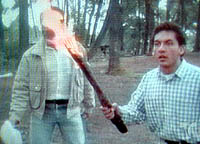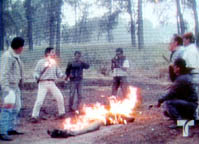


Latin American Children's
Choice of TV Programs



A major objection to television today is the fact that there are many television programs that are deemed to be unsuitable for viewing by children (e.g. see Sex and Violence on Television). In contemporary society, children are likely to spend more time with the television than at school, and so this unsuitable material may be a major influence in the formation of character and value. The standard arguments are as follows:
The counter-argument would say that there has been no scientifically rigorous study that has been able to prove that television is the cause of any social ills. Primarily, the technical difficulty is that it is impossible to isolate the effects of television from all other effects, just as the tobacco lobby had argued for years that no scientific study had proven conclusively that cigarettes was bad for health to the exclusion of all other concomitant factors. But while it is true that the proof has not yet been produced, it is hard to argue that all that sex and violence on television can be good.
So how do you control what children watch? How do you make sure that they are not watching that which they are not supposed to? To answer those questions, you must first understand how children choose the television programs that they watch.
We will now cite some data obtained in the Pan Latin American Kids' Study. This is a study of children between the ages of 7 and 11 years old in 18 Latin American countries. In the following table, we show what the kids told us who chooses the television programs that they watch (note: multiple responses are allowed). The majority of the kids indicated that they themselves are the principal decision-makers.
|
TV Program Chooser |
% among all kids |
| Self | 58% |
| Mother | 29% |
| Father | 18% |
| Brother | 11% |
| Sister | 9% |
| Other family member | 4% |
It turns out that the freedom to choose your own television programs depends heavily on the television environment. If there is only one television for the family, the small child may not be the person to make the viewing decisions. In the next table, we have grouped the kids according to the number of television sets in their homes. This table clearly shows that the kids in households with more television sets are likely to be able to choose on their own.
|
TV Program Chooser |
% among single set homes | % among two set homes | % among three set homes | % among four+ set homes |
| Self | 55% | 62% | 80% | 86% |
| Mother | 37% | 26% | 16% | 11% |
| Father | 21% | 23% | 7% | 4% |
| Brother | 14% | 11% | 5% | 6% |
| Sister | 11% | 11% | 3% | 3% |
| Other family member | 3% | 4% | 4% | 3% |
Perhaps the more relevant question is, "What happens when the child has his/her own television set?" The next table shows that when a child has his/her own television set, in about three-quarters of the time, he/she is the decision maker.
|
TV Program Chooser |
% among child with own set |
| Self | 73% |
| Mother | 20% |
| Father | 13% |
| Brother | 7% |
| Sister | 10% |
| Other family member | 6% |
So is the solution to get rid of all those extra television sets in the household to make sure that your children watch only what you watch (and, besides, are you sure that your choice would be best for your children?)? Or to take the extreme measure of tossing out all your television sets? That would be only treating the symptom, not the disease. Ultimately, the question isn't even one about the effects of television. In that sense, all the debates about program access control, television program rating and the V-chip are all beside the point. The key question is about how we are to bring our children up in an increasingly complex world. The ambiguous and conflicting messages that children receive are not limited solely to television, but come also from all walks of life.
Let us read the guidelines suggested by the U.S. Department of Education:
What is the essence of this set of suggestions? It's all about parent-child communication about the world around them. The problems start when parents cede their roles to the television set.



Vengarse Matando, Mexican B-movie seen on television, featuring a human torching.
What if your child saw this and went out to try it ... ?
![]()
WWW REFERENCES
Television Violence: A Review of the Effects on Children of Different Ages By Wendy Josephson.
Television and Children. Child Development Institute
Television, Violence and Children By Carla Karlin
Weight Status, Physical Activity and Television Viewing Habits. By Lea M. Dougherty
(posted by Roland Soong, 2/5/2001)
(Return to Zona Latina's Home Page)